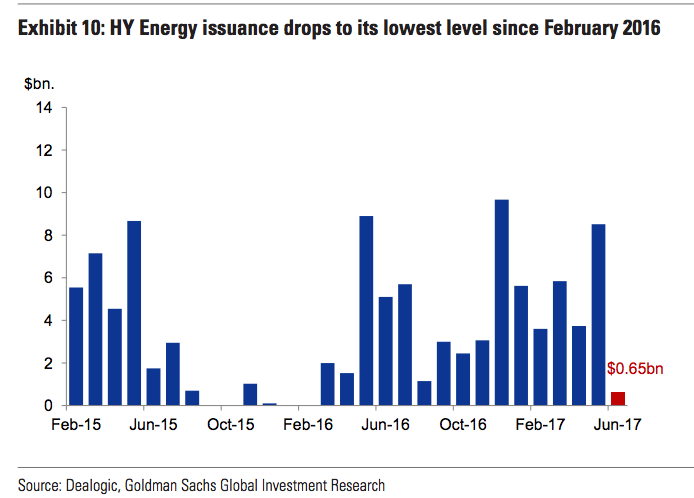Just this morning, in “‘The Clock May Stop Ticking’: Oil Price Rout Bites As HY Energy Issuance Plunges,” we noted that the downturn in crude prices (which, if this week was any indication, has morphed into a full-blown crisis of confidence) has finally caught up to the credit market, as HY Energy issuance flatlined in June:

The problem with US production is that it has effectively been subsidized by the easy money regime.
With rates perpetually suppressed and the attendant hunt for yield ongoing, otherwise insolvent producers were able to weather the downturn in prices, hibernating (as opposed to going out of business) only to reemerge after the OPEC production cut deal.
Reinvigorated by the promise of an OPEC-assisted rise in crude prices, US operators were able to tap enthusiastic debt and equity markets, as investors anticipated a veritable renaissance.
“Companies have more capital to keep drilling thanks to $57 billion Wall Street has injected into the sector over the last 18 months,” WSJ notes in a new piece called “Wall Street Cash Pumps Up Oil Production Even as Prices Sag.”
“This money has come from investors in new stock sales and high-yield debt, as well as from private equity funds, which have helped provide lifelines to stronger operators,” the Journal continues.

As we’ve noted on too many occasions to count, this is aiding and abetting a situation where these companies effectively sow the seeds of their own demise. They’re running up the down escalator. They’re working their a**es off to drive down the price of the very commodity they’re producing.
And hilariously, they think maybe you’re the problem. Here’s the Journal again:
“The biggest problem our industry faces today is you guys,” Al Walker, chief executive of Anadarko PetroleumCorp. , told investors at a conference last month.
Wall Street has become an enabler that pushes companies to grow production at any cost, while punishing those that try to live within their means, Mr. Walker said, adding: “It’s kind of like going to AA. You know, we need a partner. We really need the investment community to show discipline.”
Even if companies cut back on drilling now, it wouldn’t be enough to stop a new wave of oil from hitting the market in the second half of the year: U.S. shale output typically lags behind new drilling by four to six months, analysts say.
Shale companies are on track to spend $20 billion more than they will generate in the next six months if prices hover around $40 a barrel, analysts say.
Compensation practices play a role in the behavior of U.S. shale producers: Most of their management teams are paid based on growth or adding new oil and gas reserves—not on profits—according to Matt Portillo, an analyst at Tudor Pickering Holt & Co., in Houston. “Until that changes, growth may continue to prevail,” he said.














Leave A Comment